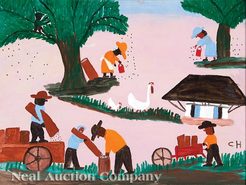 Clementine Hunter (pronounced Clementeen) was born to Creole parents in late December of 1886 or early January of 1887 at Hidden Hill Plantation near Cloutierville, Louisiana. With only a handful of days at school, Hunter would never learn to read or write and was in the fields when she was very young. At 15, she left Hidden Hill, considered to have been the inspiration for Uncle Tom’s Cabin, for Melrose Plantation.
Clementine Hunter (pronounced Clementeen) was born to Creole parents in late December of 1886 or early January of 1887 at Hidden Hill Plantation near Cloutierville, Louisiana. With only a handful of days at school, Hunter would never learn to read or write and was in the fields when she was very young. At 15, she left Hidden Hill, considered to have been the inspiration for Uncle Tom’s Cabin, for Melrose Plantation.
At Melrose, she would pick cotton, give birth (on at least one occasion picking more than 70 pounds of cotton the day before and returning to the fields within the week) to seven children, and marry Emmanuel Hunter in 1924. By her mid-30s, Clementine would begin to work as a cook and housekeeper. She would never travel more than 100 miles from home.
Melrose Plantation was something of an artist colony, and when New Orleans artist Alberta Kinsey left behind brushes and tubes of paint in the 1930s, Hunter painted her first picture – on a window shade. With the attention and support of the plantation’s curator, Francois Mignon, Hunter would get her work displayed locally. She and Mignon would also later collaborate on a Melrose Plantation cookbook.
Hunter produced artwork on any scraps she could find, from paper bags to sheetrock, hanging a sign outside her cabin that charged “25 cents to Look.” Her works illustrate the daily life of the early 20th-century plantation – picking cotton or pecans, doing chores, witnessing baptisms or weddings – and she was a prolific painter, creating an estimated 4,000 to 5,000 works, but her work is considered uneven, likely because she had to work hastily and because she continued to live in poverty most of her life, so values for her work can vary widely. Works from the 1940s and 50s are considered her best.
Hunter’s work is naïve and simplistic enough that there have been instances of forgery. This is complicated by the fact that she painted on a wide variety of materials, rarely titled works, and because there is rarely anything resembling a firm provenance. Her work also tends to sell in a price range that makes forgeries easier to pass, selling at a price point where the efforts of forging are worthwhile but where buyers are often less likely to do or demand research and are unlikely to pay for a full authentication.



